Honda CR-V: DTC Troubleshooting
DTC P0461: Fuel Level Sensor (Fuel Gauge Sending Unit) Range/Performance Problem
NOTE:
- Before you troubleshoot, record all freeze data and any on-board snapshot, and review the general troubleshooting information.
- Because it requires 162 miles (260 km) of driving without refueling to complete this diagnosis, DTC P0461 cannot be duplicated during this troubleshooting.
1. Test the fuel gauge sending unit.
Is the fuel gauge sending unit OK? YES-Check for poor connections or loose terminals at the fuel gauge sending unit and the gauge control module.
NO-Replace the fuel gauge sending unit, then go to step 2.
2. Turn the ignition switch ON (II).
3. Reset the PCM with the HDS.
4. Do the PCM idle learn procedure.
5. Check for Temporary DTCs or DTCs with the HDS.
Are any Temporary DTCs or DTCs indicated? YES-If DTC P0461 is indicated, check for poor connections or loose terminals at the fuel gauge sending unit and the gauge control module, then go to step 1. If any other Temporary DTCs or DTCs are indicated, go to the indicated DTC's troubleshooting.
NO-Troubleshooting is complete.
DTC P0462: Fuel Level Sensor (Fuel Gauge Sending Unit) Circuit Low Voltage
NOTE: Before you troubleshoot, record all freeze data and any on-board snapshot, and review the general troubleshooting information.
1. Turn the ignition switch ON (II).
2. Clear the DTC with the HDS, and wait 5 seconds.
3. Check for Temporary DTCs or DTCs with the HDS.
Is DTC P0462 indicated? YES-Go to step 4.
NO-Intermittent failure, the system is OK at this time. Check for poor connections or loose terminals at the gauge control module and the fuel gauge sending unit.
4. Turn the ignition switch OFF.
5. Fold the left side rear seat forward, and pull back the carpet to expose the access panel.
6. Remove the access panel from the floor.
7. Disconnect the fuel tank unit 4P connector.
8. Turn the ignition switch ON (II).
9. Clear the DTC with the HDS, and wait 5 seconds.
10. Check for Temporary DTCs or DTCs with the HDS.
Is DTC P0463 indicated? YES-Replace the fuel gauge sending unit, then go to step 22.
NO-Go to step 11.
11. Turn the' ignition switch OFF.
12. Remove the gauge control module.
13. Disconnect the gauge control module 36P connector.
14. Check for continuity between fuel tank unit 4P connector terminal No.1 and body ground.
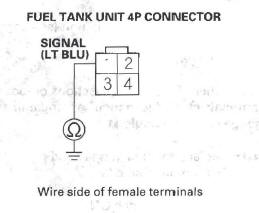
Is there continuity? YES-Repair short in the wire between the gauge control module (signal line) and the fuel gauge sending unit, then go to step 23.
NO-Go to step 15.
15. Reconnect the gauge control module 36P connector.
16. Remove the fuel tank unit.
17. Connect the fuel tank unit 4P connector.
18. Turn the ignition switch ON (II).
19. Clear the DTC with the HDS.
20. Set the float (A) to the empty position (B).
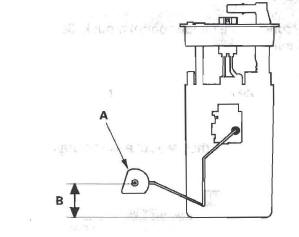
21. Check the fuel gauge.
Does the gauge move to the empty position? YES-Go to step 29.
NO-Replace the gauge control module, then go to step 22.
22. Turn the ignition switch OFF.
23. Reconnect all connectors.
24. Install the parts in the reverse order of removal.
25. Turn the ignition switch ON (II).
26. Reset the PCM with the HDS.
27. Do the PCM idle learn procedure.
28. Check for Temporary DTCs or DTCs with the HDS.
Is DTC P0462 indicated? YES-Check for poor connections or loose terminals at the gauge control module and the fuel gauge sending unit, then go to step 1.
NO-Troubleshooting is complete. If any other Temporary DTCs or DTCs are indicated, go to the indicated DTC's troubleshooting.
29. Reconnect all connectors.
30. Update the PCM if it does not have the latest software, or substitute a known-good PCM.
31. Check for Temporary DTCs or DTCs with the HDS.
Is DTC P0462 indicated? YES-Check for poor connections or loose terminals at the gauge control module and the fuel gauge sending unit. If the PCM was updated, substitute a known-good PCM, then recheck. If the PCM was substituted, go to step 1.
NO-If the PCM was updated, troubleshooting is complete. If the PCM was substituted, replace the original PCM. If any other Temporary DTCs or DTCs are indicated, go to the indicated DTC's troubleshooting.
DTC P0463: Fuel Level Sensor (Fuel Gauge Sending Unit) Circuit High Voltage
NOTE: Before you troubleshoot, record all freeze data and any on-board snapshot, and review the general troubleshooting information.
1. Turn the ignition switch ON (II).
2. Clear the DTC with the HDS, and wait for 5 seconds.
3. Check for Temporary DTCs or DTCs with the HDS.
Is DTC P0463 indicated? YES-Go to step 4.
NO-Intermittent failure, the system is OK at this time. Check for poor connections or loose terminals at the gauge control module and the fuel gauge sending unit.
4. Turn the ignition switch OFF.
5. Fold the left side rear seat forward, and pull back the carpet to expose the access panel.
6. Remove the access panel from the floor.
7. Disconnect the fuel tank unit 4P connector.
8. Connect fuel tank unit 4P connector terminal No.3 to body ground with a jumper wire.
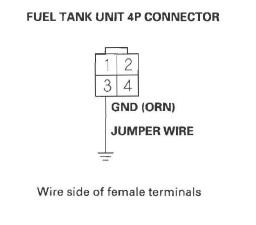
9. Remove the gauge control module.
10. Disconnect the gauge control module 36P connector.
11. Check for continuity between gauge control module 36P connector terminal No. 32 and body ground.
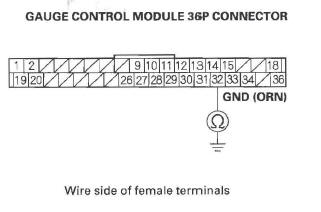
Is there continuity? YES-Go to step 12.
NO-Repair open in the wire between the gauge control module (GND line) and the fuel gauge sending unit, then go to step 24.
12. Connect fuel tank unit 4P connector terminal No.1 to body ground with a jumper wire.
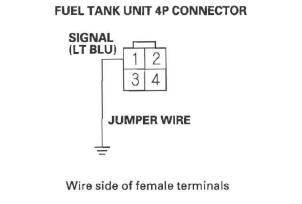
13. Check for continuity between gauge control module 36P connector terminal No. 31 and body ground.
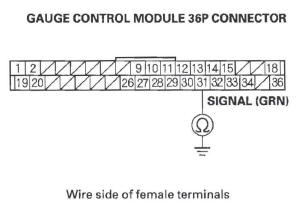
Is there continuity? YES-Go to step 14.
NO-Repair open in the wire between the gauge control module (signal line) and the fuel gauge sending unit, then go to step 24.
14. Remove the jumper wire from the fuel tank unit 4P connector.
15. Remove the fuel tank unit.
16. Test the fuel gauge sending unit.
Is the fuel gauge sending unit OK? YES-Go to step 17.
NO-Replace the fuel gauge sending unit, then go to step 23.
17. Connect the fuel tank unit 4P connector.
18. Reconnect the gauge control module 36P connector.
19. Turn the ignition switch ON (II).
20. Clear the DTC with the HDS.
21. Set the float (A) to the full position (B).
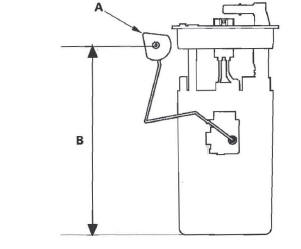
22. Check the fuel gauge.
Does the gauge move to the full position? YES-Go to step 30.
NO-Replace the gauge control module, then go to step 23.
23. Turn the ignition switch OFF.
24. Reconnect all connectors.
25. Install the parts in the reverse order of removal.
26. Turn the ignition switch ON (II).
27. Reset the PCM with the HDS.
28. Do the PCM idle learn procedure.
29. Check for Temporary DTCs or DTCs with the HDS.
Is DTC P0463 indicated? YES-Check for poor connections or loose terminals at the gauge control module and the fuel gauge sending unit, then go to step 1.
NO-Troubleshooting is complete. If any other Temporary DTCs or DTCs are indicated, go to the indicated DTC's troubleshooting.
30. Reconnect all connectors.
31. Update the PCM if it does not have the latest software, or substitute a known-good PCM.
32. Check for Temporary DTCs or DTCs with the HDS.
Is DTC P0463 indicated? YES-Check for poor connections or loose terminals at the gauge control module and the fuel gauge sending unit. If the PCM was updated, substitute a known-good PCM, then recheck. If the PCM was substituted, go to step 1.
NO-If the PCM was updated, troubleshooting is complete. If the PCM was substituted, replace the original PCM. If any other Temporary DTCs or DTCs are indicated, go to the indicated DTC's troubleshooting.

